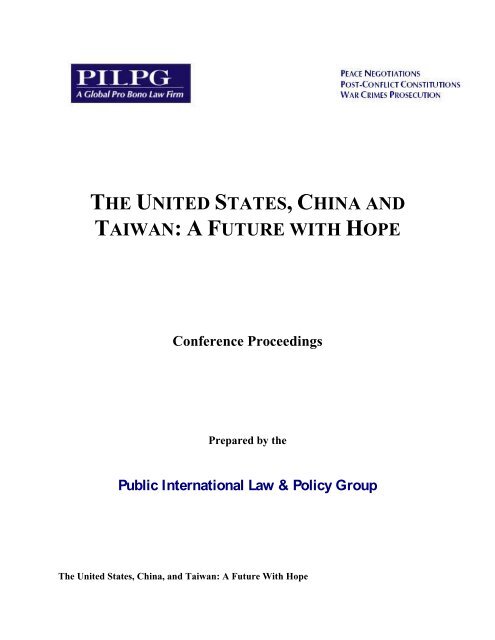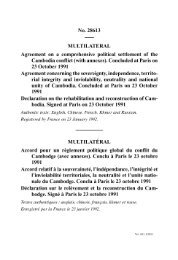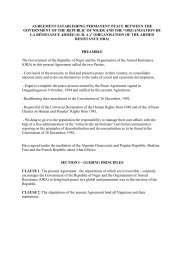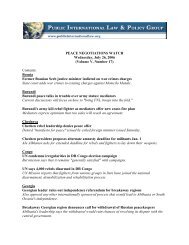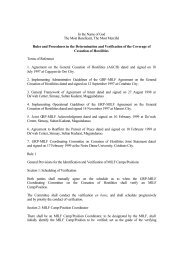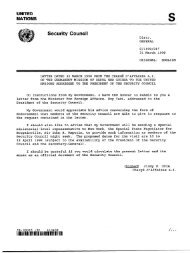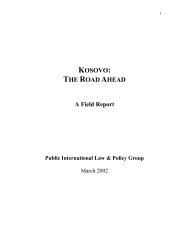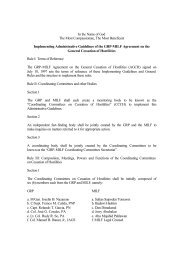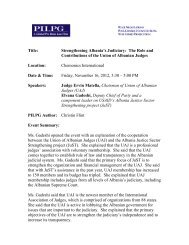The United States, China, and Taiwan - Public International Law ...
The United States, China, and Taiwan - Public International Law ...
The United States, China, and Taiwan - Public International Law ...
Create successful ePaper yourself
Turn your PDF publications into a flip-book with our unique Google optimized e-Paper software.
THE UNITED STATES, CHINA ANDTAIWAN: A FUTURE WITH HOPEConference ProceedingsPrepared by the<strong>Public</strong> <strong>International</strong> <strong>Law</strong> & Policy Group<strong>The</strong> <strong>United</strong> <strong>States</strong>, <strong>China</strong>, <strong>and</strong> <strong>Taiwan</strong>: A Future With Hope
James Lilley, Former American Ambassador to <strong>China</strong> <strong>and</strong> South Korea, <strong>and</strong> former Director ofthe American Institute in <strong>Taiwan</strong>.You have clearly worked over the complicated relationship between <strong>Taiwan</strong> <strong>and</strong> <strong>China</strong>. I canonly try to build on what Dr. Lin Chong--pin <strong>and</strong> Mr. Rostow have already described so lucidly.I would like to point out first that <strong>China</strong> chooses, for both tactical <strong>and</strong> emotional reasons, toplace a special heavy emphasis on its relationship with <strong>Taiwan</strong> <strong>and</strong> to its point that <strong>Taiwan</strong> ispart of <strong>China</strong>. Emotional, because this stirs up nationalism among a skeptical Chinese elite whohave lost ideology. Tactical, because driving home the unity <strong>and</strong> sovereignty themes forces theU.S. on the defensive, i.e., the U.S. interferes in <strong>China</strong>'s internal affairs, a cardinal sin in <strong>China</strong>'sown lexicon. In reality, however, <strong>China</strong> has been practical. For almost fifty years Chinesepropag<strong>and</strong>a has focused on <strong>Taiwan</strong> as a pure target, but objective circumstances have changed<strong>and</strong> so has <strong>China</strong>'s strategy. <strong>China</strong> took over the Ta Chen Isl<strong>and</strong>s peacefully in 1954, its lastsignificant territorial acquisition in the <strong>Taiwan</strong> Strait. Its later more militaristic approach againsta well--defended Quemoy (Chin men) failed in 1958, <strong>and</strong> <strong>China</strong> retreated with much bluster <strong>and</strong>firing of cannons, many of them empty.<strong>The</strong> <strong>Taiwan</strong> Relations Act (TRA), passed in 1979 after the U.S. <strong>and</strong> <strong>China</strong> normalized relations,provided much needed continuity to U.S. assurances concerning <strong>Taiwan</strong>'s security after theMutual Defense Treaty had been terminated. <strong>The</strong> assurances were given teeth for the first timesince Quemoy, when, in March 1996, the U.S. sent two carrier battle groups off the east coast of<strong>Taiwan</strong> in response to Chinese missile shots <strong>and</strong> its threatening military live fire exercises. Thisaction was consistent with Admiral Arleigh Burke's admonition that the best preventive of war isa credible deterrence. But as often seems to be the case, the dramatic actions by the U.S. <strong>and</strong><strong>China</strong> were obscured by caricature <strong>and</strong> demagoguery as well as with simplistic judgments. "<strong>The</strong>[*744] Chinese had backed down" was one cry, or that the U.S., by its actions, had provoked aChinese military build--up was another. And further, that the U.S. was afraid to send its carriersinto the actual Strait out of fear of Chinese missiles, or that the Chinese military got a black eyebecause of its ineffective adventurism.In the end, Lee Teng--hui won a l<strong>and</strong>slide election victory in spite of angry Chinese threatsagainst him. But this was the tenor of much of the commentary.Getting back to Chinese shifting strategy, Chinese statements have slowly evolved over theyears. "We must liberate <strong>Taiwan</strong>" was the belligerent war cry of the 1950s <strong>and</strong> 1960s, even in theface of a growing Soviet threat to <strong>China</strong> in the north. This particular war cry began to soundemptier <strong>and</strong> emptier as the Soviet build--up grew on <strong>China</strong>'s northern border <strong>and</strong> the horribleGreat Leap Forward campaign, the worst of Mao's lunatic social engineering, almost destroyedthe livelihood of the provinces facing <strong>Taiwan</strong> in the southeast. <strong>The</strong> population, as a result, ratherthan wanting to liberate <strong>Taiwan</strong> was probably more anxious for its material help.Later, Chinese rhetoric started to use the term "unification" or "reunification" in Marshall YehChienying's nine points in 1979. Now we hear "one country, two systems" often repeated <strong>and</strong>applied to Hong Kong.
<strong>The</strong> transition so far has been somewhat successful but perhaps is less appropriately applied to<strong>Taiwan</strong>, which is of course a very different case. We are also hearing the mantra repeated of"sacred sovereignty" <strong>and</strong> "inviolable unity," which are repeated largely for a Chinese domesticaudience but are also aimed at the overseas Chinese. <strong>International</strong>ly, this rings of nineteenthcentury gunboat imperialism, so it is less effective in international circles. <strong>The</strong> Chinese have alsosucceeded in inserting into the American media's lexicon such terms as <strong>Taiwan</strong>, the "renegadeprovince," or <strong>Taiwan</strong> referred to as the <strong>Taiwan</strong> Question, the <strong>Taiwan</strong> Problem, or the <strong>Taiwan</strong>Mine Field. This is a slick pejorative touch which has largely worked. Finally, Americanssupportive of <strong>China</strong>, egged on by the Chinese themselves, now repeat these words: any Chineseleader who shows any give on <strong>Taiwan</strong> is out of a job. Historically, this does not hold up asChinese leaders have consistently shown "give" on <strong>Taiwan</strong> <strong>and</strong> survived intact. <strong>The</strong>y havesurvived Quemoy, the <strong>Taiwan</strong> Relations Act, <strong>and</strong> the sale of frigates, S--70 helicopters, <strong>and</strong>F--16s to <strong>Taiwan</strong>. As the Chinese say, firm in principle (<strong>Taiwan</strong> is ours), flexible in tactics(accept the F--16 sales).Finally, <strong>China</strong> <strong>and</strong> its American supporters are now trying to put the blame squarely on <strong>Taiwan</strong>for the major downturn in U.S.--Chinese relations in 1995. In that way <strong>Taiwan</strong> then becomesresponsible for U.S. policy failures ---- a convenient scapegoat. <strong>Taiwan</strong> is not necessarily [*745]blameless, but the real reasons for the downturn were U.S. vacillation <strong>and</strong> provocative bungling<strong>and</strong> <strong>China</strong>'s frustrated over--reaction. "<strong>The</strong> fault, Dear Brutus . . . ."Chinese leaders no doubt posture <strong>and</strong> manipulate among themselves on <strong>Taiwan</strong>, as Qiao Shi didin 1995--96 in order to outflank his rival for leadership. <strong>The</strong> military in <strong>China</strong> consistently playsthe heavy, probably in a Chinese—orchestrated campaign to give more prominent civilians anice guy image. <strong>The</strong> U.S., true to form, often reacts with clichés <strong>and</strong> other readily availablesubstitutes for thought. "Would American boys die for <strong>Taiwan</strong>?" "What business of ours is thiscivil war in Asia?" "Los Angeles could go up in smoke."<strong>The</strong> Coming Conflict with <strong>China</strong> school of though has it that the Chinese are ten feet tall <strong>and</strong> thatthe Chinese are coming. America's intellectuals on <strong>China</strong> are br<strong>and</strong>ed as apologists (soundsfamiliar?). And then the other reaction, the defenders of <strong>China</strong>, are equally as flawed <strong>and</strong>probably more dangerous in the long run. <strong>The</strong>y say, do not mention the Chinese threat becausethis could become "a self--fulfilling prophecy." In a word, shut up. <strong>The</strong>y report that <strong>China</strong> hasnever been expansionist <strong>and</strong> is too far behind militarily for us to bother about. Furthermore, theChinese military budget is the smallest per capita <strong>and</strong> is only four percent of ours. <strong>China</strong>,therefore, cannot project power the way we can. <strong>The</strong>se are specious arguments originatinglargely from analysts who have never worn a uniform or fired a gun.Since 1985, <strong>China</strong> has in fact developed a Positive Defense strategy (Jiji Fangyu). This involvesestablishing a security belt around <strong>China</strong>'s most vulnerable coastal areas ---- to secure an innerisl<strong>and</strong> chain which stretches from the Spratly Isl<strong>and</strong>s <strong>and</strong> Paracels in the South <strong>China</strong> Sea whichprotect <strong>China</strong>'s southern flank centered around Hong Kong <strong>and</strong> Guangdong, to <strong>Taiwan</strong> in theeast which would protect <strong>China</strong>'s southeastern <strong>and</strong> eastern booming coastal areas up to Shanghai,<strong>and</strong> then to the Diao Yu Dao (Senkaku) Isl<strong>and</strong>s protecting the East <strong>China</strong> Sea, <strong>and</strong> finallyanchoring in the Korean Peninsula where <strong>China</strong> seeks to share power with the U.S. by increasingits own influence in this historically strategic peninsula.
<strong>China</strong>'s dominant military concept now is to be prepared to fight high--tech limited wars on itsperiphery against weaker opponents. To accomplish this, <strong>China</strong> conveys the perception to theoutside world that it is backward ---- as Sunzi said: "When capable, feign incapacity" ---- but atthe same time stakes out its territorial claims in domestic National Peoples' Congress (NPC)legislation. <strong>The</strong> NPC law of 1992, claiming the Spratly, Diao Yu Dao Isl<strong>and</strong>s, <strong>and</strong> <strong>Taiwan</strong> <strong>and</strong>reserving the right to use force, backs up these claims. Is this contrast between modernizing[*746] its military, insisting it is obsolete, <strong>and</strong> then claiming the seas around <strong>China</strong> a seemingcontradiction? Yes, it is, but if you are not prepared to deal with contradictions, then you do notbelong in the <strong>China</strong> business.<strong>China</strong> has a track record of frequently using violence to sort out sovereignty issues on itsperiphery, so the isl<strong>and</strong> chain concept is not entirely new. As Jonathan Wilkenfeld, head of theUniversity of Maryl<strong>and</strong>'s ICONS project has pointed out, <strong>China</strong> has used force more frequentlythan any other nation since 1949, citing Vietnam, Burma, India, Soviet Union, Korea, <strong>and</strong><strong>Taiwan</strong> Strait ---- all instances where force was used. Justifications for the use of force can bedebated; the fact that force was used cannot be.Historically, <strong>and</strong> history certainly counts in current Chinese calculations (certainly more thanwith the U.S.), John K. Fairbank, who paid a lot of attention to the trends of dynastic history,carefully <strong>and</strong> wisely came up with three Chinese principles governing its strategy:(1) stop the primary threat from the l<strong>and</strong> ---- the Great Wall was built at enormous cost to stopthe northern barbarians. It was not always successful, given the Mongol <strong>and</strong> Manchu victories;(2) downgrade sea power ---- with some notably brief exceptions in the southern Song <strong>and</strong> earlyMing dynasties;(3) establish moral superiority ---- ultimately it is not force of arms but the superiority of yourcivilization which exp<strong>and</strong>s your influence <strong>and</strong> protects the motherl<strong>and</strong>.As with all principles, at times they were followed, <strong>and</strong> at times they did not work. Certainly, theeunuch Admiral Zheng He's seven maritime expeditions in the early Ming dynasty, when <strong>China</strong>ruled the waves, was abruptly stopped to turn inward <strong>and</strong> to build <strong>China</strong>'s strength <strong>and</strong> protect itagainst any resurgent Mongols in the north. In the Qing dynasty, a major miscalculation wasmade when Li Hong--zhang, who wanted to build up <strong>China</strong>'s sea power after the disastrousOpium War, was overruled by the emperor in favor of Zuo Zong--tang, who wanted toemphasize l<strong>and</strong> forces against the Russians <strong>and</strong> Mongols in the north. <strong>The</strong> result was a disasterfor <strong>China</strong> as the major threat continued to come from the sea ---- Japan in 1895 <strong>and</strong> 1931. <strong>China</strong>also experienced humiliation at the h<strong>and</strong>s of eight foreign powers during the Boxer Rebellion in1900, <strong>and</strong> these forces came from the sea as well.Recently, <strong>China</strong> has been torn. Certainly in the 1950s, during the heyday of Sino--Sovietcooperation, <strong>China</strong>'s military industrial strength moved inl<strong>and</strong>, led by Chinese revolutionariesfrom inl<strong>and</strong> provinces such as Hunan, Sichuan, <strong>and</strong> Shanxi. <strong>The</strong> coastal areas dominated by[*747] foreign colonialists were decimated ---- Shanghai was a main target.
However, the Soviet break with <strong>China</strong> in 1960 altered this, but <strong>China</strong> still turned inward to the"third line" to protect against the Soviet threat. In an orgy of paranoia <strong>and</strong> defensiveness, <strong>China</strong>built huge useless mounds, bristling with guns, surrounded by moats, filled with undergroundstorage chambers, all along the traditional invasion routes of <strong>China</strong>. Mao's lunacy reigned: digdeep tunnels, <strong>and</strong> they were dug deep at a huge cost ---- <strong>China</strong>'s new Great Wall.But <strong>China</strong> was not completely engulfed by this foolishness. This was the era when theyconcentrated efforts on engineers <strong>and</strong> scientists, many trained in the U.S. <strong>and</strong> USSR, to buildICBMs, nuclear bombs, <strong>and</strong> nuclear powered submarines. <strong>The</strong>re were two <strong>China</strong>s (no allusionmeant to present political hang--ups): one backward, poverty--stricken, mired in mass programssuch as People's War, <strong>and</strong> one scientific, modern, forward--looking, <strong>and</strong> capable.<strong>The</strong> Chinese argued with themselves about whether <strong>China</strong> should modernize, adapt westernways, look outward to the east to the blue waters of the ocean, or whether they should remaininward--looking, bogged down in the chauvinistic <strong>and</strong> isolated Yellow River culture. He Shang(the Yellow River elegy) captured this in 1988 in a popular television series which supported thelook outward <strong>and</strong> ridiculed <strong>China</strong>'s past preoccupation with itself. It was initially backed by ZhaoZhiyang, the deposed party leader, but was later emphatically banned in 1988.Today, <strong>China</strong> sees its l<strong>and</strong> borders with the Central Asia republics <strong>and</strong> Russia as largely non--threatening <strong>and</strong> seeks to stabilize them. Boris Yeltsin's visit to <strong>China</strong> in May 1996 put the cap onthis in a glittering, but slightly ridiculous, gr<strong>and</strong> meeting in Shanghai where a border agreementwas signed with much fanfare by Yeltsin, Jiang Zemin, <strong>and</strong> leaders of the Central Asianrepublics. Chinese strategists were quick to point out, a year later during a visit of our NationalDefense University, that now <strong>China</strong> would look eastward ---- to <strong>Taiwan</strong>. Its l<strong>and</strong> borders werenow secure, <strong>and</strong> so to solidify its security it would turn eastward toward <strong>Taiwan</strong>, the isl<strong>and</strong>chains, <strong>and</strong> to Greater <strong>China</strong>.<strong>The</strong> leadership in Beijing today is not from Sichuan or Hunan, but is largely from the coast ----namely Shanghai, which has risen phoenix--like from the ashes. Economics <strong>and</strong> money are thepreferred engines of influence, but there must be a major miliary component which can feed oneconomic growth <strong>and</strong> also exploit the once--in--a--lifetime opportunities by drawing on a brokendown but militarily useful Russia. <strong>The</strong> lessons of history are that <strong>China</strong> now should turnoutward, extend its sovereignty, strengthen its security, <strong>and</strong> neutralize its opposition on itsperiphery.<strong>Taiwan</strong> is a principal target of this strategy, to be used economically, to be circumscribeddiplomatically, to be isolated politically, <strong>and</strong> to be neutralized militarily. <strong>The</strong> spiritual pollutionof democracy must be negated in <strong>Taiwan</strong> <strong>and</strong> in Hong Kong because the current Chineseleadership believes that <strong>China</strong> must remain under the political control of a single communistparty backed by a strong <strong>and</strong> modernized military. <strong>Taiwan</strong> must be pulled into the Chinese orbit---- the way this is done, given past shifts, probably can be worked out over time through cross--strait dialogue. In the short--term, the Chinese are banking on this tactic.
But <strong>China</strong> also needs to have the U.S. <strong>and</strong> <strong>China</strong>--watching establishment arguing <strong>and</strong> bickeringamong itself over <strong>China</strong>'s future course, particularly its military. This is happening, <strong>and</strong> in a wayit reminds me of the global warming debate.Both <strong>China</strong> watchers <strong>and</strong> environmentalists share a body of data which is common to both sidesof the debate <strong>and</strong> is based partly on scientific or technical data collection. This data is analyzedby so--called experts who come to widely different interpretations. <strong>The</strong> two sides then fight <strong>and</strong>the arguments become emotional <strong>and</strong> fixed, often ending in ad hominem attacks which are usedagainst the opposition. <strong>The</strong> debate becomes mired in disagreement, <strong>and</strong> policy can becomestultified <strong>and</strong> at times even paralyzed. It could be tragic, because, as in global warming, thestakes are very high for all mankind.President Clinton's first term <strong>China</strong> policy was bogged down in groping experimentation, littleunderst<strong>and</strong>ing of the forces at work, <strong>and</strong> a distorted view of how to manage policy with both<strong>China</strong> <strong>and</strong> <strong>Taiwan</strong>. <strong>The</strong> result was the crisis in March of 1996. Perhaps the Administration hasnow learned to act more wisely after that scare. But the problem of underst<strong>and</strong>ing <strong>and</strong>evaluating the Chinese military remains. Cass<strong>and</strong>ras are popping up all over, warning that<strong>Taiwan</strong> could be the catalyst for military confrontation. <strong>The</strong> necessity remains for us to beclear—headed when we look at the meaning of Chinese military acquisitions from Russia.Unfortunately, our data is only the tip of the iceberg. What is then the Chinese revolution inmilitary affairs? Its research <strong>and</strong> development appears targeted on dealing with advanced U.S.weapons systems which they observed being used in the Gulf War <strong>and</strong> which could eventuallybe used against a hostile <strong>China</strong>. Chinese research is aimed at using Russian torpedo technologyagainst our aircraft carriers; other programs counter--act our stealth bombers, <strong>and</strong> they seek withlaser weapons to put out the eyes of our satellites on which so much of our warfare depends. Allof these programs are being pursued by <strong>China</strong>. Where they st<strong>and</strong> is a matter for our intelligenceagencies.In any case, getting back to the Chinese security belt <strong>and</strong> its inner isl<strong>and</strong> chain strategy, in eachof its selected areas it runs into U.S. military commitments or into U.S. forward deployed forces.In the Spratlys, we demonstrated, in May 1995, that the sea lanes passing through that area arecritical to the U.S., our friends, <strong>and</strong> allies. <strong>The</strong> Chinese belatedly acknowledged our position. In<strong>Taiwan</strong>, we have the TRA <strong>and</strong> have shown as recently as March 1996 our resolve to back it up.<strong>The</strong> Senkakus issue is not clear, <strong>and</strong> the U.S. insists it takes no position on the issue ofsovereignty, but the Japanese have insisted, mostly privately, that our security treaty covers theseisl<strong>and</strong>s <strong>and</strong> they have the back--up data to make their case. We are still the major player on theKorean Peninsula, <strong>and</strong> we are essential in deterring war <strong>and</strong> bringing about peaceful economicchange in the north. <strong>China</strong> also is. Can these two giant countries agree to share influence whilethe Koreans themselves are left to work out their own destiny peacefully? <strong>China</strong> <strong>and</strong> the U.S.both know well the bitter cost of warfare on that peninsula. Striking progress has been madewhen we have cooperated, but the dangerous dilemma remains of an obnoxious over--militarized<strong>and</strong> failed regime in the North clinging to power <strong>and</strong> resisting real change for fear it will end itsrule. <strong>The</strong> oversized military is its only card ---- the threat of force ---- this is an immediateproblem calling for Chinese--American cooperation.
<strong>The</strong> U.S., on the Korean Peninsula <strong>and</strong> elsewhere in East Asia, must steadfastly st<strong>and</strong> behindonly peaceful means to resolve disputes. Association of Southeast Asia Nations (ASEAN)supports this in the South <strong>China</strong> Sea as reflected in the Manila Declaration of 1992. <strong>Taiwan</strong>ceased hostilities in the <strong>Taiwan</strong> Strait seven years ago, <strong>and</strong> <strong>China</strong> has also belatedly done thesame, as was stated in Jiang's eight points in early 1995. <strong>Taiwan</strong>--<strong>China</strong> high level talks shouldbe resumed as soon as possible with each side supporting one <strong>China</strong> but having its ownindividual interpretation of what this means, as was the case in the Singapore meeting of 1993.Japan--U.S.--<strong>China</strong> trilateral talks, starting with the two track talks, could defuse some of <strong>China</strong>'sacute concerns about the new guidelines for U.S.--Japan security cooperation. <strong>The</strong> Diao Yu Dao"Senkaku" Isl<strong>and</strong>s controversy should not merit a concentration of resources. Nationalistjingoism needs to be curtailed in <strong>China</strong> <strong>and</strong> Japan.<strong>China</strong> has recently demonstrated pragmatism in its more realistic approach to proliferation ofWeapons of Mass Destruction (WMD) to Iran ---- this could augur well for other areas if it playsout. <strong>International</strong> organizations should play an increasingly constructive role, particularly intrade. Both <strong>China</strong> <strong>and</strong> <strong>Taiwan</strong> are in Asian Pacific [*750] Economic Cooperation (APEC), in theAsian Development Bank, <strong>and</strong> should soon be in World Trade Organization (WTO). Free <strong>and</strong>open trade <strong>and</strong> investment by 2010 for developed countries <strong>and</strong> 2020 for developing countriesare laudable APEC goals which involve both <strong>Taiwan</strong> <strong>and</strong> <strong>China</strong>. A Regional Operations Centerin <strong>Taiwan</strong> would probably make cooperation between the ASEAN countries, <strong>China</strong>, <strong>and</strong> <strong>Taiwan</strong>more effective <strong>and</strong> expansive. <strong>China</strong>'s restraint so far in Hong Kong could mean Hong Kong willmaintain its role as a financial <strong>and</strong> service center for East Asia <strong>and</strong> its continuing prosperity isessential to <strong>China</strong>'s economic reforms as is <strong>Taiwan</strong>'s stability <strong>and</strong> prosperity. <strong>China</strong> must bepractical if it is to keep this important asset for its much needed reforms spelled out at theFifteenth Party Congress.Hence, I remain somewhat guardedly optimistic. A key to Asian stability <strong>and</strong> prosperity remainsthe successful future of <strong>Taiwan</strong> in the context of a peaceful <strong>and</strong> prosperous <strong>China</strong>. We must allwork to make this happen.


